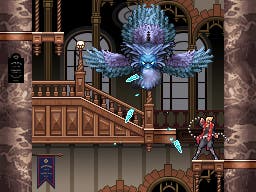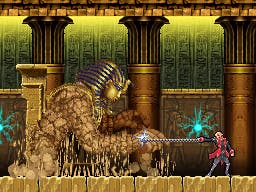Castlevania: Portrait of Ruin
Revamped.
Fittingly for a game fronted by a pair of opposites, there are two ways to look at Castlevania: Portrait of Ruin. The gung-ho fan, presumably fresh from one of the slash-heavy 3D console versions, will enjoy battling a broad range of new enemies, and running the arduous gauntlet of countless sub-quests in pursuit of new and enjoyably diverse weapons and tools.
But others, like me, who found greater pleasure in the last DS game's cunning marriage of exploration and discovery - greeting every new ability with a little yelp of excitement, before running off to see how it might help thread more of the world together - will be left somewhat cold.
The compound view is that this isn't as broadly appealing as Dawn of Sorrow, but it is at least trying new things.
Portrait of Ruin follows on from events in the Megadrive Bloodlines game (take my word for it), and puts players in the boots of two young vampire-hunters - Jonathan and Charlotte - who are trying to take down Dracula's Castle, rebuilt for the umpteenth time thanks to an influx of wandering souls from the ongoing second World War.
The introduction of a second character has a big impact, but mainly around the edges. At the core, you're still playing a 2D platformer brimming with RPG elements - as well as running along and whacking people with your whip or sword, you need to buy lots of health potions, make sure you're hunting down and equipping the best tools and armour, and keep engaging the enemy to ensure you level up.

But that's not to say Jon or Charles is in any way superfluous, despite the obvious way their abilities dovetail. Jonathan is more of a weapons master, with the fondly remembered whip at his side and various sub-weapons to accumulate (the closest thing to Dawn of Sorrow's soul collection). Charlotte, meanwhile, is a magic specialist. She can use a book for melee attacks (leading to the rather excellent discovery that you can whack people in the head with Don Quixote), while excellent and powerful spells fuel her main advantage over the undead.
Two halves of one character then, in some senses, but various methods of combining their forces allow you to strike harder than any one character might. Combination attacks can be earned and put to use - helpful, particularly, in boss fights - while orbs can be collected to introduce collaborative skills, like being able to push a button and then have the other character hop through an opening doorway, or for one to jump off the other's shoulders.
Obviously it's all done in arbitrarily silly and contradictory videogame fashion - they can't be separated for long, you can summon and dismiss the other character into the ether, and you only have to get one through a door for both to be through the door. Then again, if you're that picky, I doubt you got past "vampire" in the fourth paragraph.

The castle environment our two heroes explore together is a healthier size than perhaps expected, and that's largely thanks to the game's other hook - the portraits. In addition to simply exploring, you also have to climb into these to break down the castle's magic. Each portrait is an environment all of its own - a town, a desert, a circus - that needs to be fought and explored in the usual manner, often with a greater density of enemies to overcome, before you can relieve a boss monster of a pivotal new ability and return to the main castle to continue.
As much of a deviation as that sounds, though, Castlevania's trademark non-linearity isn't really bred here - and is more easily located in elements like the ghostly Wind character, who offers you sub-quests to complete. More than just fetch-quests, these are often quite cryptic and involve a bit of preparation - approaching Wind while you're enduring a curse status, for example, or when you're out of cash. The rewards are new weapons, accessories, and sometimes crucial abilities.
All of which sounds quite arresting on paper, and certainly speaks to a greater degree of imagination on the part of the developer than a typical sequel might. Where something like Yoshi's Island DS, which I faced off with last week, sought merely to decorate the successes of its predecessor, Portrait of Ruin paints the basic elements in a more thoughtful manner. It's quite an admirable approach.

It's not without quirks and niggles, mind. Individual elements that sound quite intriguing have a tendency to suffer under closer examination. The application of two characters, for example, proves a bit fiddly, with lots of commands to learn before you can face complex scenarios with confidence and skill. Meanwhile, puzzles that rely on both are sometimes awkward. You can stand in a mine cart while the other character pulls a lever, and then quickly switch back to the one in the mine cart to smash down walls, but as you ride along the remaining character flickers in and out of synch with your position. The developer doesn't seem confident of these elements - and it shows, not least in the great big green outlines they whacked around them so you wouldn't give up and assume you were doing the wrong thing.
Really though it's the loss of things that Dawn of Sorrow did so well that limits Portrait's appeal to me. In DoS, every discovery was a wellspring of greater discoveries. Like Zelda, it kept you interested in what you were doing, but often left tempting hints of greater treasures just beyond your character's present capacity. The discovery of some new tool or ability drove you back to those areas, but better perhaps than Zelda, you could easily find them thanks to the ever-present top-screen map, with the real secrets harder to find but more satisfying for it. It also placed few restrictions on how you got to things, which, along with the depth of the weapons and soul elements, helped personalise the experience.
Portrait of Ruin's weighted away from this approach, preferring instead to try and keep the other kind of Castlevania fan happy. Things like the portrait levels merely emphasise this with their repetition and relative linearity - insignificant to many whose entertainment stems from character development, weapon harvesting, combat and narrative, but crucial to people who prefer to explore and discover.

On these terms, Portrait of Ruin is rather dull by comparison, and things like irritating dialogue don't help draw you into the other elements of the experience. Doubly annoying because in quite a few respects PoR improves on its immediate predecessor. Gone are the daft conclusions to boss fights, which forced you to draw symbols with the stylus, while a new co-op element (though sadly not for the main game) and an online shop for buying and selling items to friends work very well, even over the Internet, and help you overcome tougher challenges or find enjoyment, even when you're stuck in the game proper. Graphically, too, Konami does a fine job of blending 2D and 3D elements without looking absurd - hard to do, and effectively done.
Even so I just didn't feel the same magic, the same excitement that flowed from Sorrow. Whether you will all depends on how you approach it, and it would be rude and silly of me to declare that this has no merit simply because I fall outside the impact zone of some of its best ideas and mechanics (especially with so many wonderful bonuses and unlockables squirreled away for those with the patience to uncover them). Equally though, I can't very well recommend it completely, because it's just not doing the things I love.


